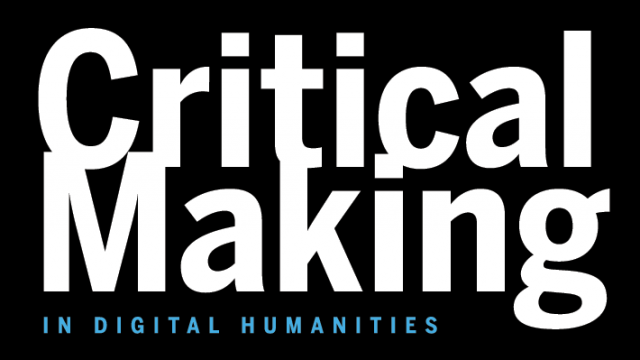In conjunction with the “Critical Making in Digital Humanities” panel at MLA 2014, panelists Roger Whitson and Dene Grigar are curating a digital archive of projects to highlight work that combines critical inquiry with DIY-making methodologies and the digital humanities.
Many scholars in digital humanities make things as part of their critical and theoretical activity, and — in so doing — refuse the knowing/doing dichotomy present in some academic circles. From the artistic book practices of Johanna Drucker, the heuretics of Gregory Ulmer, and the serious games of Ian Bogost to the performance work of electronic literature, the artisan materiality of DIY culture, and the speculative character of design fiction, digital humanities has a long history of what Matt Ratto calls “critical making.” For Ratto, critical making “is an elision of two typically disconnected modes of engagement in the world– ‘critical thinking,’ often considered as abstract, explicit, linguistically-based, internal and cognitively individualistic; and ‘making,’ typically understood as material, tacit, embodied, external, and community-oriented” (52). As Jean Bauer has argued, databases are “steeped in theoretical implications,” and we add, so are programming languages, data models, interfaces, algorithms, and the heads, spindles, platters, motors, and plastruders found in hardware and printers. In short, methods, tools, and applications exist in recursive relationships with discursive practices. But beyond that, makers are passionately involved in critically assessing and intervening in culture. For instance, consider Jason Freeman, Carl DiSalvo and Michael Nitsche’s Urban Remix, Nick Montfort and Stephanie Strickland’s Sea and Spar Between, and Hugh Crawford’s Thoreau House, all of which engage digital humanities, maker cultures, and critical theory.
We seek further projects that underline, highlight, question, or otherwise complicate the assumptions currently circulating about critical theory, the humanities, and maker culture. Projects may include digital work, analogue mechanisms, made-objets, databases, hardware, or other scholarly ephemera. Here are a few sample questions:
- How can making help us understand literary theory and history?
- How have making practices enabled the oppression of minorities? What is the role of making in contesting that oppression?
- What role do the humanities have in helping to shape the emerging world of customized manufacturing through technologies like 3D-printing?
- What are the borderlands between digital programming, electronic literature, circuit-bending, and DIY maker culture? Can we complicate those boundaries?
- What would a making-centered pedagogy look like in a critical theory class?
- What is the history of maker culture?
- What are the implications of maker culture for scholarly communication?
Please send proposals (and URLs to accompanying websites either displaying or documenting the project) in the form of a 300-word abstract to roger.whitson -at- wsu.edu and dgrigar -at- vancouver.wsu.edu.. Selected projects will be featured on this site.
